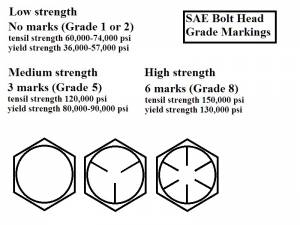Table of Contents
Strengths Of Various Fasteners
Grade Marks and Material Properties for Bolts and Screws
Bolts, screws and other fasteners are marked on the head with a symbol that identifies the grade of the fastener. 1)
The grade specification establishes the minimum mechanical properties that the fastener must meet.
Additionally, industrial fasteners must be stamped with a registered head mark that identifies the manufacturer.
The grade identification table identifies the grade markings and gives mechanical properties for some commonly used ASTM and SAE steel fasteners.
Metric fasteners are identified by property grade marks, which are specified in ISO and SAE standards.
These marks are discussed with metric fasteners.
Mechanical Properties and Grade Markings of Nuts
Three grades of hex and square nuts designated Grades 2, 5, and 8 are specified by the SAE 1995 standard covering nuts in the 1/4“ to 1-1/2” diameter range. 3)
Grades 2, 5, and 8 nuts roughly correspond to the SAE specified bolts of the same grade.
Additional specifications are given for miscellaneous nuts such as hex jam nuts, hex slotted nuts, heavy hex nuts, etc.
Generally speaking; use nuts of a grade equal to or greater than the grade of the bolt being used.
- Grade 2 Nuts:
- Grade 2 nuts are not required to be marked.
- Grade 5 Nuts (1/4“ to 1-1/2” range):
- A dot on the face of the nut and a radial or circumferential mark at 120° counterclockwise from the dot.
- Or a dot at one corner of the nut and a radial line at 120° clockwise from the nut.
- Or one notch at each of the six corners of the nut.
- Grade 8 Nuts (1/4“ to 1-1/2” range):
- A dot on the face of the nut with a radial or circumferential mark at 60° counterclockwise from the dot.
- Or a dot at one corner of the nut and a radial line at 60° clockwise from the nut.
- Or two notches at each of the six corners of the nut.
Detecting Counterfeit Fasteners
Fasteners with markings identifying them as a specific grade or property class are counterfeit if they don't meet standards established for that class. 4)
Counterfeit fasteners may break unexpectedly at smaller loads than expected.
Generally, these fasteners are made from the wrong material or they are not properly strengthened during manufacturing.
Either way, counterfeit fasteners can lead to dangerous failures in assemblies.
The law now requires testing of fasteners used in some critical applications.
Detection of counterfeit fasteners is difficult because the counterfeits look genuine.
The only sure way to determine if a fastener meets it's specification is to test it.
However, reputable distributors will assist in verifying the authenticity of the fasteners they sell.
For important applications, fasteners can be checked to determine whether they perform according to the standard.
Typical lab checks used to detect fakes include testing hardness, elongation, ultimate loading and a variety of chemical tests.

